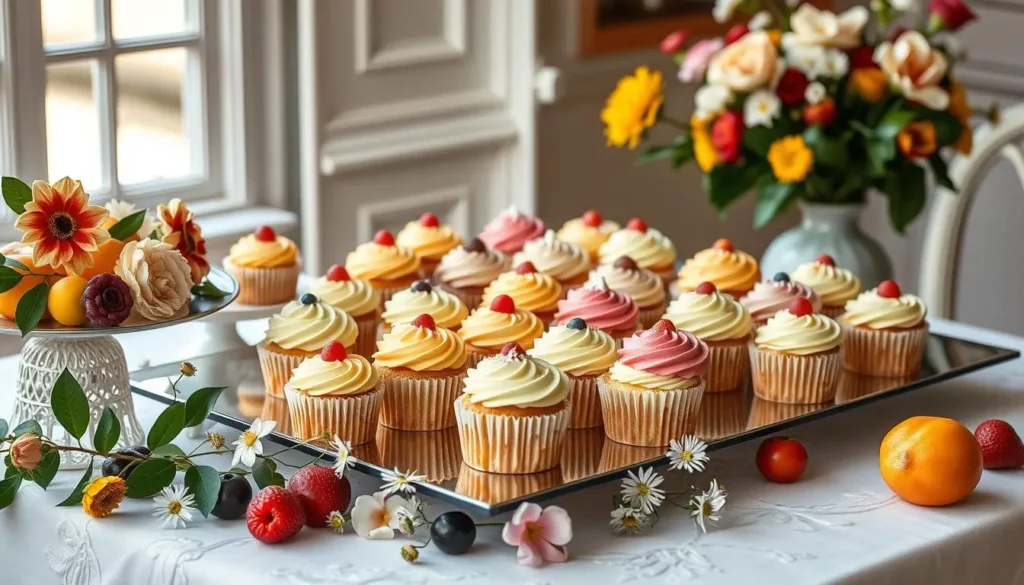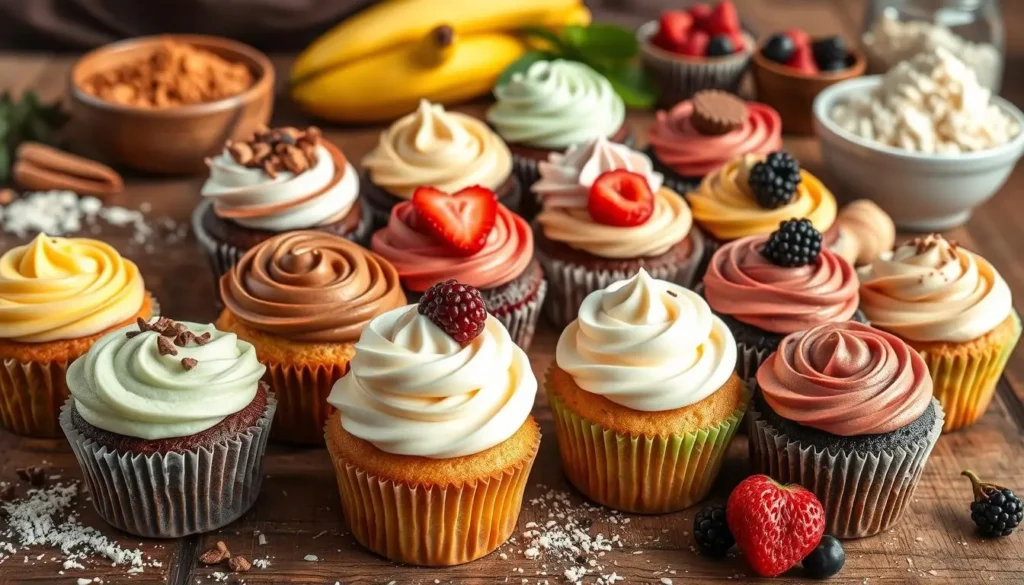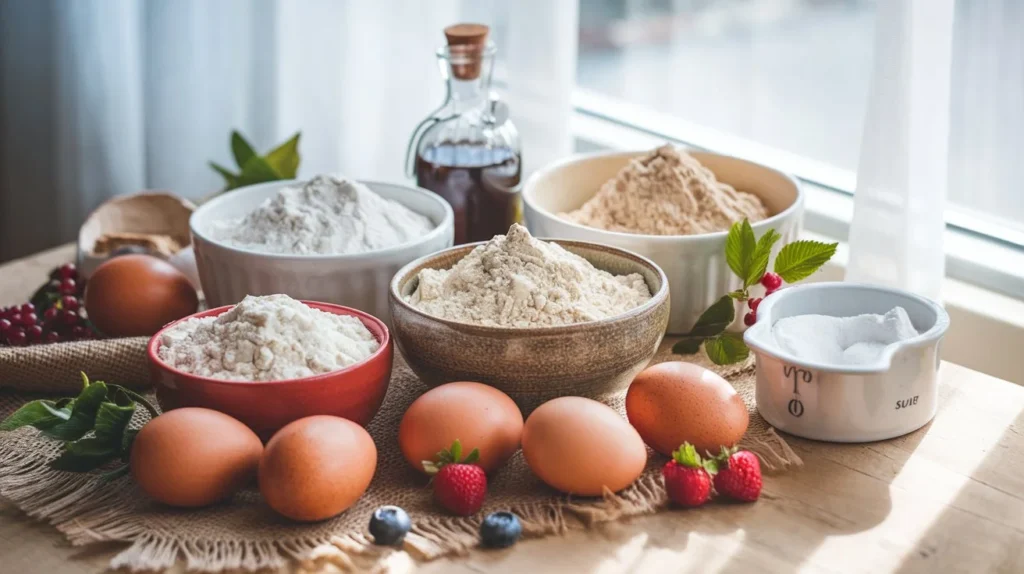Imagine enjoying a delicious cupcake that’s safe for those with gluten sensitivities. Gluten free cupcakes have revolutionized dessert options, offering gourmet delights for everyone, including those on celiac-friendly diets.
Table of Contents

Baking without wheat doesn’t mean losing flavor or texture. Modern methods and new ingredients have made gluten-free baking an art. Whether you’re on a special diet or just want healthier desserts, this guide will show you how to make irresistible cupcakes.
You’ll learn about different flour blends and how to keep your treats moist. Discover the secrets to making wheat-free desserts that taste like the real thing. Get ready to improve your baking and wow everyone with gluten-free treats that are truly unbeatable.
Key Takeaways
- Gluten free cupcakes can be just as delicious as traditional versions
- Special techniques make wheat-free treats moist and flavorful
- Alternative flour blends are key to successful celiac-friendly desserts
- Understanding ingredient interactions is crucial in gluten-free baking
- Anyone can learn to bake amazing wheat-free cupcakes with the right knowledge
Understanding the Magic Behind Gluten Free Cupcakes
Gluten-free baking has changed the sweet treat world. It offers tasty choices for those with dietary limits. Exploring gluten-free cupcakes opens a world of creativity and healthy treats.

What Makes a Cupcake Gluten-Free?
A gluten-free cupcake doesn’t use wheat flour. Instead, it uses flours that don’t have gluten. These include:
- Almond flour
- Coconut flour
- Rice flour
- Chickpea flour
Benefits of Going Gluten-Free
Gluten-free sweets are more than just a choice. They open up new flavors. People with celiac disease or gluten sensitivity can enjoy treats without harming their health.
| Health Benefit | Description |
|---|---|
| Reduced Inflammation | Eliminates potential digestive triggers |
| Improved Digestion | Easier on sensitive digestive systems |
| Nutrient Diversity | Introduces varied alternative flour nutrients |
Common Misconceptions About Gluten-Free Baking
Many think gluten-free baking means losing taste and texture. This couldn’t be further from the truth! With the right ingredients and techniques, gluten-free cupcakes can be just as good as regular ones.
“Gluten-free baking is an art of innovation, not compromise.” – Pastry Chef Elena Rodriguez
Learning these basics will help you make amazing gluten-free cupcakes. They’re perfect for everyone, no matter their dietary needs.
Essential Ingredients for Celiac-Friendly Cupcake Success

Starting your gluten-free cupcake journey is all about the right ingredients. You’ll find the perfect flours for your celiac diet. These flours make baking safe and tasty.
Finding the best flours is key for delicious cupcakes. Here are some top picks:
- Almond flour: Adds rich, nutty flavor and moisture
- Rice flour: Provides light, delicate texture
- Coconut flour: Enhances natural sweetness
- Sorghum flour: Offers smooth, neutral taste
“The secret to amazing gluten-free cupcakes lies in understanding how different flours interact and complement each other.” – Professional Pastry Chef
Binding agents are vital for gluten’s role in baking. Xanthan gum and psyllium husk help your cupcakes stay together and not crumble.
For the best gluten-free baking, follow these tips:
- Use fresh, high-quality alternative flours
- Measure ingredients precisely
- Experiment with flour blend combinations
- Always check ingredient labels for potential gluten contamination
Your cupcake success depends on choosing ingredients that work well together. This creates a texture and flavor that’s just as good as traditional wheat-based treats.
Mastering Alternative Flour Blends for Perfect Texture
Making tasty grain-free cupcakes is all about flour blends. It’s not just about replacing wheat. It’s about mixing flours for great taste and texture in your desserts.
Finding the right flour mix is key to great wheat-free baking. Not all flours are the same. Each one adds something special to your cupcakes.
Top Gluten-Free Flour Combinations
- Almond flour + rice flour for a light, tender crumb
- Coconut flour + tapioca starch for moisture retention
- Sorghum flour + potato starch for improved structure
Understanding Protein Content in Alternative Flours
Protein is important for the right texture in grain-free cupcakes. Flours have different proteins that affect how they turn out.
| Flour Type | Protein Content | Best Used For |
|---|---|---|
| Almond Flour | 21% | Dense, moist cupcakes |
| Coconut Flour | 14% | Light, airy textures |
| Sorghum Flour | 11% | Balanced structure |
Achieving the Perfect Crumb Structure
Getting a tender, moist crumb in wheat-free baking takes some work. Experiment with various flour blends to achieve the ideal texture.
“The art of gluten-free baking is about understanding each ingredient’s unique properties and how they work together.” – Gluten-Free Baking Expert
With the right knowledge, your grain-free cupcakes can be just as good as the traditional ones. Explore the world of alternative flours for endless healthy dessert options.
Must-Have Equipment for Gluten-Free Baking
To make your gluten-free bakery dreams come true, you need more than just tasty recipes. The right tools are key to making allergy-friendly sweets that everyone will love.
“Accuracy is crucial in gluten-free baking—your tools are your ultimate allies!” – Professional Pastry Chef
Setting up your gluten-free kitchen requires some essential tools. These tools help avoid cross-contamination and ensure your baked goods are always a hit.
- Separate mixing bowls for gluten-free preparations
- High-quality kitchen scale for precise measurements
- Silicone baking cups for easy removal
- Stand mixer with multiple attachments
Your goal should be to keep gluten away while still baking amazing treats.
| Equipment Type | Purpose in Gluten-Free Baking | Recommended Material |
|---|---|---|
| Mixing Bowls | Prevent Cross-Contamination | Stainless Steel or Ceramic |
| Baking Pans | Even Heat Distribution | Non-Stick Aluminum |
| Measuring Tools | Accurate Ingredient Portions | Digital Kitchen Scale |
Investing in dedicated gluten-free baking equipment is not just a recommendation – it’s a necessity for creating safe, delicious treats.
Tips and Tricks for Moisture Management in Wheat-Free Treats
Making tasty wheat-free treats is all about managing moisture in gluten-free baking. With the right methods and ingredients, your cupcakes can go from dry to moist.
Starting with healthy indulgences means understanding moisture in gluten-free baking. Wheat-free treats often face texture issues. But, with some smart strategies, you can improve your baking.
Preventing Dry and Crumbly Textures
Dry cupcakes are a big problem in gluten-free baking. Here are some key tips to avoid them:
- Use liquid sweeteners like honey or maple syrup
- Add extra egg yolks for extra richness
- Measure ingredients carefully
- Avoid mixing your batter too much
Natural Moisture-Adding Ingredients
Use these natural ingredients to add moisture to your gluten-free baking:
- Greek yogurt
- Applesauce
- Mashed bananas
- Olive oil
- Pumpkin puree
“The secret to phenomenal gluten-free cupcakes is understanding how ingredients interact to create moisture and texture.” – Professional Baker
Storage Solutions for Freshness
Proper storage keeps your wheat-free treats fresh. Keep cupcakes in an airtight container at room temperature for 2-3 days, or refrigerate for up to a week. Remember, let cupcakes cool completely before storing to avoid moisture buildup.
By following these tips, your gluten-free baking will yield moist, delicious cupcakes that everyone will enjoy.
Dairy-Free and Vegan Variations for Inclusive Baking
Creating vegan cupcakes is more than a trend. It’s a tasty way to make your baking welcoming to all. Dairy-free options have improved a lot, offering tasty choices for those with dietary needs or who prefer ethical food.
When making allergy-friendly recipes, choose ingredients that keep the taste and texture right. Plant-based milks like almond, oat, and coconut add moisture and richness to your gluten-free cupcakes.
“Baking is about creating joy that everyone can experience, regardless of dietary limitations.” – Professional Baker
- Egg Substitutes:
- Mashed bananas
- Flax or chia seeds
- Applesauce
- Commercial egg replacers
- Plant-Based Milk Options:
- Almond milk
- Oat milk
- Coconut milk
- Soy milk
Vegan butter alternatives like coconut oil or vegetable shortening can replace traditional dairy butter perfectly. These ingredients not only make your cupcakes dairy-free but can also boost their flavor.
Try different mixes to find your ideal vegan cupcake recipe. Remember, texture and moisture are crucial for making delicious dairy-free treats that everyone will enjoy.
Frosting Fundamentals for Allergy-Conscious Decorating
Decorating cupcakes is more than just fun; it’s about making everyone feel included. To do this, you need to know how to make frostings that are safe for all. This requires creativity and a good understanding of what ingredients to use.
Alternative Buttercream Options
When it comes to dairy-free desserts, you need to think outside the box. Here are some amazing frosting options that are perfect for decorating:
- Coconut cream-based frosting
- Cashew buttercream
- Aquafaba meringue frosting
- Avocado chocolate frosting
Natural Food Coloring Choices
Creating vibrant desserts is easy with natural coloring. Here are some plant-based ways to add color:
| Color | Natural Source |
|---|---|
| Pink | Beet juice |
| Yellow | Turmeric |
| Green | Spinach powder |
| Purple | Blueberry extract |
Piping Techniques for Beautiful Finishes
Turn your cupcakes into stunning works of art with piping techniques. Mastering different tips and angles will help you create beautiful designs. These designs will wow both kids and adults.
Pro tip: Always keep your piping bag at a consistent 90-degree angle for smooth, even frosting application.
By using these tips, you can make delicious cupcake decorations. These decorations will not only look great but will also be safe for everyone to enjoy.
Troubleshooting Common Gluten-Free Baking Challenges
Gluten-free baking can seem like a complex maze. People on a celiac diet or who prefer wheat-free baking often face frustrating challenges. These can make making cupcakes seem impossible. Knowing these common problems can make your gluten-free baking better.
“Creativity turns dietary restrictions into a delicious celebration!” — Professional Pastry Chef
Let’s look at the most common gluten-free baking problems and how to solve them:
- Sunken Cupcake Middles: Caused by incorrect moisture balance or undermixing
- Dense Textures: Resulted from heavy alternative flours
- Crumbly Consistency: Typically from lack of binding agents
- Uneven Rising: Often due to inconsistent ingredient temperatures
To tackle these issues, try these strategies:
| Baking Challenge | Recommended Solution |
|---|---|
| Sunken Centers | Use xanthan gum, measure ingredients precisely |
| Dense Texture | Blend multiple gluten-free flours, add light starches |
| Crumbly Cupcakes | Incorporate eggs, increase binding agents |
Getting good at gluten-free baking takes practice and knowing how ingredients work together. See each problem as a chance to get better at wheat-free baking.
Pro Tip: Always let ingredients come to room temperature before mixing. This helps get the best texture and consistency.
Creative Flavor Combinations and Mix-ins
Turning dietary restriction sweets into amazing treats needs creativity and skill. Your gluten-free cupcakes can become something truly special. This is thanks to the right mix of flavors and ingredients.
Seasonal Flavor Adventures
Seasonal ingredients make healthy treats even better. Here are some exciting flavor ideas:
- Autumn: Pumpkin spice with maple glaze
- Summer: Lemon lavender with berry compote
- Winter: Peppermint chocolate with crushed candy cane
- Spring: Strawberry basil with fresh mint garnish
Texture Enhancement Magic
It’s not just about taste when making allergy-friendly sweets. You can also add mix-ins to improve the texture:
- Toasted nuts for crunch
- Chia seeds for nutritional boost
- Dried fruit for natural sweetness
- Coconut flakes for tropical flair
Kid-Friendly Flavor Experiments
Make gluten-free treats fun for kids. Try rainbow sprinkle cupcakes, chocolate chip surprise, or fruity swirl designs. These ideas make dietary restrictions fun and exciting.
“Creativity is the secret ingredient in making dietary restrictions feel like a celebration!” – Gluten-Free Baking Expert
Conclusion
Your journey to making tasty gluten free cupcakes is just starting. You’ve learned how to make desserts that are good for you and fun to eat. You now know how to mix different flours, keep your cupcakes moist, and try new flavors.
Trying out new dessert recipes is now super fun. Every recipe you try is a chance to get better and find new ways to make cupcakes that everyone loves. You’re ready to dive into gluten-free baking with confidence and creativity.
Remember, making great gluten-free treats is all about passion, practice, and knowing your ingredients. Whether you’re making treats for special diets or just to try something new, these tips will help you make cupcakes that are moist and delicious, just like the regular kind.
Your baking journey is just starting. Take on the challenge, trust what you’ve learned, and keep exploring the world of gluten-free cupcakes. With patience and creativity, you’ll soon be making treats that everyone at the table will love.
FAQ
Do gluten-free cupcakes taste different?
Slightly—they can be denser or have a different texture, but the right recipe makes them just as delicious.
How to keep gluten-free cupcakes moist?
Use ingredients like yogurt, applesauce, or extra eggs, and store them properly in an airtight container.
What is the secret to gluten-free baking?
Precision, the right flour blend, and moisture-rich ingredients for the best texture.
Does gluten-free flour affect cake baking?
Yes, it absorbs more liquid and may need binders like xanthan gum to improve texture.
What exactly makes a cupcake gluten-free?
A gluten-free cupcake doesn’t have wheat, barley, rye, or other grains with gluten. Instead, it uses flours like rice, almond, or coconut. It also has xanthan gum to help it hold together like gluten does.
Are gluten-free cupcakes more difficult to bake than traditional cupcakes?
Gluten-free baking can be tricky, but it’s doable. With the right ingredients and techniques, you can make moist and tasty cupcakes. The key is to know how to mix flours, manage moisture, and use the right binders.
Can I make gluten-free cupcakes if I don’t have celiac disease?
Yes, you can! Gluten-free cupcakes are great for anyone, not just those with dietary needs. Many people enjoy them for health reasons or to try new baking methods.
What are the best alternative flours for gluten-free cupcakes?
Top flours include almond, rice, coconut, and gluten-free mixes. Each has its own benefits. Mixing them can help you find the perfect texture and taste.
How can I prevent my gluten-free cupcakes from becoming dry?
To keep them moist, use applesauce, yogurt, or extra eggs. Don’t overmix the batter. Adding ingredients like mashed bananas or Greek yogurt helps too. Keep them fresh by storing in an airtight container.
Are gluten-free cupcakes more expensive to make?
Gluten-free cupcakes might cost a bit more because of special ingredients. But, buying in bulk and making your own blends can lower the cost.
Can I make vegan and gluten-free cupcakes?
Yes! Use plant-based milks, flax eggs or aquafaba, and dairy-free frosting. Many ingredients can make treats that are safe for everyone.
How long do gluten-free cupcakes stay fresh?
Gluten-free cupcakes last 2-3 days in an airtight container at room temperature. You can refrigerate them for up to a week or freeze for three months.
What equipment do I need to make gluten-free cupcakes?
You’ll need separate bowls and tools to avoid gluten contamination. A kitchen scale, silicone cups, and a mixer are also key. A scale is especially important for gluten-free baking.
Can I convert my favorite traditional cupcake recipe to gluten-free?
Yes, you can make traditional recipes gluten-free. Just replace wheat flour with a gluten-free blend, add xanthan gum, and adjust liquids as needed. Getting it right may require some trial and error.

